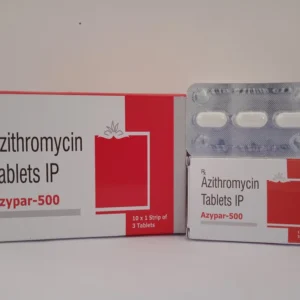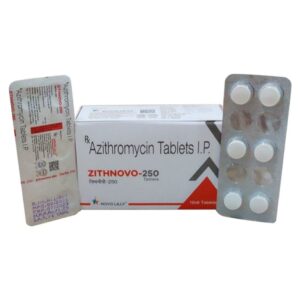Azithromycin 1000mg is a high-dose, broad-spectrum macrolide antibiotic designed to combat a wide range of bacterial infections. Known for its long half-life and excellent tissue penetration, Azithromycin works by inhibiting bacterial protein synthesis, effectively stopping the growth and spread of bacteria in the body. It is most commonly used for treating respiratory tract infections, skin and soft tissue infections, and certain sexually transmitted infections.
Product Highlights:
-
Generic Name: Azithromycin
-
Strength: 1000mg
-
Dosage Form: Oral Tablet
-
Pharmacological Class: Macrolide Antibiotic
-
Route of Administration: Oral
-
Packaging: Available in blister packs or bottles, typically 1 tablet per pack (single-dose therapy)
Indications and Uses:
Azithromycin 1000mg is prescribed for the treatment of moderate to severe infections caused by susceptible bacteria, including:
-
Respiratory Tract Infections: Acute bacterial sinusitis, community-acquired pneumonia, bronchitis, and pharyngitis/tonsillitis
-
Skin and Soft Tissue Infections: Including uncomplicated skin infections caused by Staphylococcus aureus or Streptococcus pyogenes
-
Sexually Transmitted Infections (STIs): Chlamydia trachomatis urethritis and cervicitis, and as part of combination therapy for gonorrhea
-
Traveler’s Diarrhea: Caused by susceptible strains of Escherichia coli
-
Mycobacterial Infections: As part of a combination regimen in HIV patients to prevent or treat Mycobacterium avium complex (MAC) infection
Mechanism of Action:
Azithromycin binds to the 50S ribosomal subunit of susceptible microorganisms, thereby inhibiting bacterial protein synthesis. This bacteriostatic action prevents bacteria from growing and reproducing, allowing the body’s immune system to eliminate the infection more effectively.
Dosage and Administration:
-
Standard Adult Dosage: One-time dose of 1000mg orally, usually taken on an empty stomach (1 hour before or 2 hours after meals).
-
STI Treatment: Often used as a single-dose therapy for uncomplicated Chlamydia infections.
-
Note: Dosage and duration of therapy may vary based on the type and severity of infection, and should be determined by a licensed healthcare provider.
Pharmacokinetics:
-
Absorption: Rapidly absorbed with peak plasma concentrations occurring within 2 to 3 hours.
-
Half-Life: Prolonged terminal half-life (up to 68 hours), allowing once-daily dosing or single-dose therapy.
-
Metabolism & Excretion: Primarily excreted unchanged in bile; minor renal excretion.
Contraindications:
-
Known hypersensitivity to Azithromycin, erythromycin, or other macrolide antibiotics.
-
History of cholestatic jaundice or hepatic dysfunction associated with prior Azithromycin use.
Warnings and Precautions:
-
Use with caution in patients with hepatic or renal impairment.
-
May prolong QT interval; caution advised in patients with pre-existing cardiac conditions or those taking other QT-prolonging agents.
-
Clostridium difficile–associated diarrhea (CDAD) has been reported with nearly all antibacterial agents, including Azithromycin.
Potential Side Effects:
Common side effects may include:
-
Nausea
-
Diarrhea
-
Abdominal pain
-
Headache
Less common but serious side effects:
-
Allergic reactions (rash, angioedema, anaphylaxis)
-
Hepatotoxicity
-
Cardiac arrhythmias (QT prolongation)
Storage Instructions:
-
Store at controlled room temperature (15°C to 30°C / 59°F to 86°F).
-
Protect from moisture and direct sunlight.
-
Keep out of reach of children.
Why Choose Azithromycin 1000mg?
-
Convenience: Single-dose therapy improves patient compliance, especially for STIs.
-
Broad-Spectrum Coverage: Effective against a wide range of Gram-positive and Gram-negative bacteria.
-
Trusted & Widely Used: Recommended in multiple treatment guidelines worldwide.
-
High Tissue Penetration: Achieves therapeutic levels in target tissues for extended durations.
Note: This product description is intended for informational purposes only. Azithromycin 1000mg should be used only under the supervision of a licensed healthcare provider. Always consult with a physician or pharmacist before starting any antibiotic treatment.



